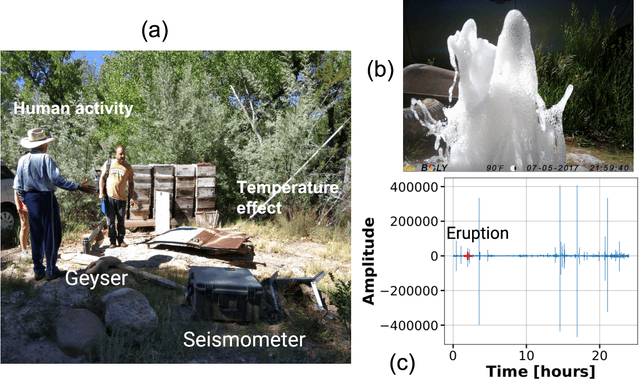C. N. L. Gammans
Using Machine Learning to Discern Eruption in Noisy Environments: A Case Study using CO2-driven Cold-Water Geyser in Chimayo, New Mexico
Oct 01, 2018



Abstract:We present an approach based on machine learning (ML) to distinguish eruption and precursory signals of Chimay\'{o} geyser (New Mexico, USA) under noisy environments. This geyser can be considered as a natural analog of $\mathrm{CO}_2$ intrusion into shallow water aquifers. By studying this geyser, we can understand upwelling of $\mathrm{CO}_2$-rich fluids from depth, which has relevance to leak monitoring in a $\mathrm{CO}_2$ sequestration project. ML methods such as Random Forests (RF) are known to be robust multi-class classifiers and perform well under unfavorable noisy conditions. However, the extent of the RF method's accuracy is poorly understood for this $\mathrm{CO}_2$-driven geysering application. The current study aims to quantify the performance of RF-classifiers to discern the geyser state. Towards this goal, we first present the data collected from the seismometer that is installed near the Chimay\'{o} geyser. The seismic signals collected at this site contain different types of noises such as daily temperature variations, seasonal trends, animal movement near the geyser, and human activity. First, we filter the signals from these noises by combining the Butterworth-Highpass filter and an Autoregressive method in a multi-level fashion. We show that by combining these filtering techniques, in a hierarchical fashion, leads to reduction in the noise in the seismic data without removing the precursors and eruption event signals. We then use RF on the filtered data to classify the state of geyser into three classes -- remnant noise, precursor, and eruption states. We show that the classification accuracy using RF on the filtered data is greater than 90\%.These aspects make the proposed ML framework attractive for event discrimination and signal enhancement under noisy conditions, with strong potential for application to monitoring leaks in $\mathrm{CO}_2$ sequestration.
 Add to Chrome
Add to Chrome Add to Firefox
Add to Firefox Add to Edge
Add to Edge